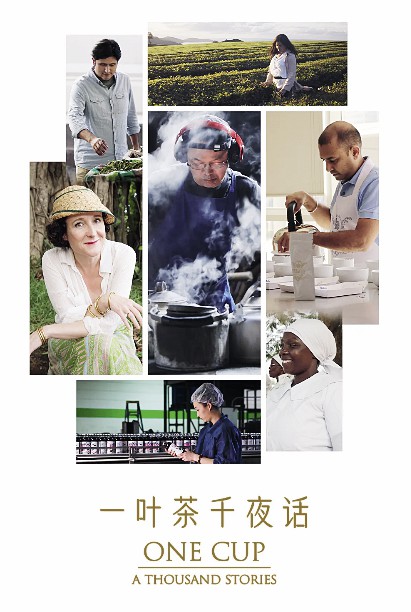
The Culture of Tea – from China to the World
One Cup, A Thousand Stories
Length: 6 episodes
52 Minutes per episode
Produced by BBC Studios
Tea is one of the greatest gifts that China has given to the world. The visually stunning six-episode documentary One Cup, A Thousand Stories filmed and produced by BBC Studios tells the stories of the hot drink that has changed the world in surprising ways and seeks to understand what lies behind people’s timeless love of tea.
Over the past three years, the film crew traveled to 13 countries and regions across six continents, from high mountains to wild coasts, allowing people to tell their own fascinating tales and present to the audience the important role and far-reaching impact of tea culture in the evolution of Chinese and even global civilizations. Through their lens, the audience will discover what has made tea a key part of human history, and then peer into the future to see how tea is evolving in an ever-changing world.
In the first episode “For the Love of Tea,” the film crew explores the early origins of tea and meets with the De’ang people living in the high mountains of Yunnan’s Dehong Dai and Jingpo Autonomous Prefecture who believe that tea was a gift from their gods. They have a special sour tea made from naturally fermented tea leaves. The special tea making skill has been passed down for centuries. “Tea is a very precious thing, and a heavenly gift to us,” said Li Yansuo, a young De’ang man who learned the craft of making the sour tea from his mother, hoping to preserve their rich tea culture.
There are other touching stories that would move the audience in this episode. For example, in the century-old teahouse in Guanyin Pavilion in Chengdu, southwest China’s Sichuan Province, local residents drink a cup of jasmine tea every morning while chatting or playing cards. These real-life scenes are heartwarming for viewers. Faraway in Penang, Malaysia’s cultural melting pot, a bride serves tea at the wedding ceremony to her own parents and in-laws, which means leaving home and being accepted by a new family. The ritual of tea still plays a powerful role in the most important events of many people’s lives.
The culture of tea is steeped in tradition, yet tea is constantly evolving. In the second and third episodes – “The Art of Tea,” and “Tea for the Soul,” the film crew traveled to different parts of the world to decode what lies behind our enduring love of tea. They discover how a Chinese businesswoman attains inner peace as she embraces a unique tea ceremony, and how the English have raised their own form of drinking afternoon tea to a whole new level. The documentary also ventures from the earthly world to a spiritual realm, where a monk Master Yinzong in the small village of Guzhu in the eastern province of Zhejiang has dedicated 16 years of his life to bringing back to life the most revered tea and its preparation skills that can be traced back to the Tang Dynasty (618-907). There is also the story of the herder Bolor in Mongolia – set in one of the most primeval landscapes on the planet, who welcomes the family’s ancestral spirit into this world with a bowl of Mongolian tea.
Throughout the centuries, tea has been transported from its birthplace China to almost every corner of the world. In the fourth episode “To the Ends of the Earth,” an ancient road snaking through the Himalayas – the Tea Horse Trail, is pictured. Kesang Tashi, a Tibetan businessman, recalls that when he was a boy of 10, he went along with his parents on a 45-day horse caravan journey from Qamdo to Lhasa. Sixty-five years later, Tashi returned to northern Yunnan to launch a new tea named after the tea brand Nobu Mebar created by his beloved grandfather. It used to be renowned back in the day, and now a legacy that Tashi wants to revive.
Tea drinking is a daily ritual for billions of people, but there are a variety of preparation techniques and types. In the fifth episode “The Taste of the Tea Trade,” the film crew travels to the North Island of New Zealand, where farmers couple the extraordinary tea bushes with the use of specially designed technology to create a truly remarkable flavor of tea. While in the U.S.A., a Chinese woman named Evy Chen is taking on the biggest growth area in the tea business with the “ready-to-drink” tea bought off the shelf, which has adapted traditional Chinese flavors to the needs of the American market.
Modern life in fast-paced cities is threatening old traditions. But some daring tea makers see changes not as a problem, but as an opportunity to take tea into the future. In the final episode “Tea Without Limits,” the viewers discover that bubble tea, or pearl tea, has turned the tea industry upside down, and is rapidly rising in popularity. It is typically a mix of ice, tea, milk, sugar, and most importantly, tapioca. Lin Hsiu-Hui, chief product officer of Chun Shui Tang Tea in Taipei, loved eating the chewy and tasty tapioca balls when she was a child. Then in 1987, aged 18, Lin got a job serving oolong tea at Chun Shui Tang. Inspired by the idea of iced tea, she added the tapioca balls and mixed them together. Thus, bubble tea was born.
Tea culture is rooted in traditions that go back millennia, but it is also innovative, experimental, and limitless. In the 21st century, tea is on a new journey. In this documentary series, audience will discover the power of tea, the power to communicate and love, and the power to express complex ideas through tea culture. If only tea could talk, it would tell a thousand stories.